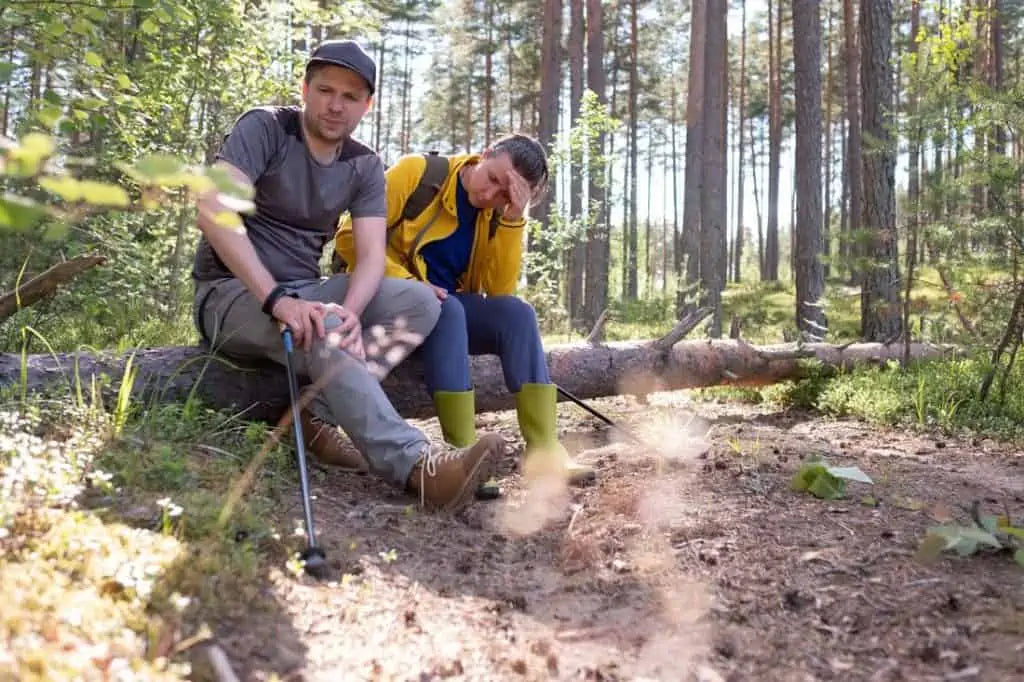Knee Pain After Hiking: Causes And Treatments
March 28 2023 – Nysh Website

Outdoor activities like hiking helps reduce stress and is a great way to include physical activity in your daily routine. Hiking gives you the opportunity to appreciate nature, explore new trails, and relax your mind. But many hikers complain of knee pain post their hike. As experienced a hiker you are, you must have had at least one instance where you experienced knee pain after your hike. So let’s get to the root of it!
Why Do My Knees Hurt After Hiking?
Your knees do a lot for you, especially when you’re on a hike. They bear the weight of your hiking bags and help you climb uphill and downhill slopes while hiking. Knee pains are very common among hikers who spend a lot of time traversing rocky and uneven terrain. Many hikers complain of pain around and behind their kneecaps and feel stiffness in their knees.
Research also suggests that the force our knees take when climbing downhill is eight times more than our normal body weight. So, you can imagine the amount of weight our knees take upon themselves while hiking! Other hiking injuries include pain on the inner side of your knees, which is usually due to a muscle sprain or ligament tear.
Causes Of Knee Pain After Hiking
There can be several causes for knee pain after hiking. It can either be from wearing the wrong kind of shoes or missing out on warm-up exercises before you start your hike. Here are some of the most common causes of knee pain after hiking.
1. Wearing The Wrong Shoes
One of the most common causes of knee pains after a hike is wearing the wrong kind of hiking shoes. Your shoes should offer you solid ankle support and should protect your knees and feet while hiking. Any pair of good hiking/trekking shoes will have thick soles, that are meant to minimize the impact of your climbing on your knees. Your ideal pair of hiking shoes should fit you well, provide plenty of support, and have lots of cushion to absorb the impact of your steps.
2. Descending Wrong While Hiking Downhill
One might believe, that the ascending is the difficult part of the hike. But you’d be surprised that it is actually the downhill descend that is quite fickle and difficult. While hiking downhill, the bulk impact of your body is directly on your knees, which not only causes pain but can also damage the knees. One way to avoid this is by adopting a switchback pattern or zig zag pattern while hiking. It may be a bit more tedious than a normal descend downhill, but you’re knees won’t have to support as much weight as before.
3. Carrying A Heavy Bag For Your Hike
If you overpack and have more gear than you actually need, then you’re simply hauling a lot of unwanted dead weight along with you. Any extra gear or even a heavy backpack is simply extra weight that your knees have to support other than your own body weight. A heavy hiking bag means weight on your shoulders and neck, this can affect your hiking posture and cause more strain on your knees and ankles, which can result in knee pains and other injuries. So, try and pack light, and only stick to the essentials.
4. Not Stretching Or Warming Up Before Your Hike
Before any sort of intense workout or exercise, it is important to stretch and warm yourself up. Warm-ups facilitate to make your joints more mobile, they loosen your muscles, and increase your flexibility. They also reduce the chances of workout-related injuries and help with muscle stiffness. Make sure you stretch and do some basic warm-ups before starting your hike. Without any such preparations, there are chances of strain or sudden pull of the ligaments and tissues around the joints like your knees, which can cause knee pains.
5. Not Using Hiking Sticks
If you already have some underlying knee condition or have had previous experience of knee pain while hiking you should consider using trekking poles. These provide you with extra support and help redistribute your weight to your arms and your core. They also provide extra balance and provide you with a sense of control. Some of these sticks also come with impact shock absorbers to decrease the impact on your arms. These poles are great for downhill hikes and protect your knees from your body weight.
6. Not Wearing A Knee Brace
Another possible cause of having a knee pain after a hike is not providing enough support to your knees. Other than hiking sticks, knee braces are also effective in providing your knees with some extra support. Knee braces specifically designed for hiking come with side stabilizers and gel padsfor tendon support. On the other hand, everyday knee braces do not come with these added advantages and may cause more harm than good.
How To Treat Knee Pain After Hiking?
Recovery from any strenuous activity like workouts and hikes is important to relax your sore muscles. There are several easy and effective ways to take care of your knee pain after your hiking expedition.
1. Massages
Massages are a great way to alleviate knee pain and are also extremely relaxing and soothing. They increase blood circulation to the massaged areas, which aids with the healing process. You can use good massage oils or even some pain relief ointments to soothe the pain and stimulate the tender muscles.
2. RICE Method
The RICE method is popularly recommended to treat various muscle and ligament-related injuries like sprains, tears, and muscle pulls. It is a pretty simple first-aid technique that can help alleviate swelling, decrease pain, and promote healing. Here’s what the acronym stands for:
Rest: Whenever your body is hurt or ill your first instinct is to rest. So, go ahead and rest your injured leg. Make sure not to worsen the injury by lifting something heavy or exerting the knee more than required.
Ice: The next step is to apply ice to the affected area. Icing helps with reducing swelling and relieve pain. Either use ice gel packs or place some ice cubes in an absorbent cotton towel and apply it to your knee for 15-20 minutes every 2-3 hours, until the swelling subsides.
Compression: If the swelling does not subside even after applying ice, then you can use compression. It is essentially a wrapping technique wherein you gently wrap the injured area with a medical bandage. Just make sure you don’t wrap it too tight to lower blood circulation, and don’t leave the bandage on for too long.
Elevate: Finally, you need to elevate the sore limb to a comfortable height. This reduces pain and swelling. After hiking, one might experience ankle sprains which are quite common. Elevate the affected limb by stacking some pillows underneath your leg and lying down to lessen the pain.
3. Pain Relief Medications
If the pain is too much and you need some instant relief, then you can opt for over-the-counter pain relief medications. That will offer you quick relief and some temporary recovery. If you need stronger medication you should consult a physician, who will then prescribe appropriate medications. You can also use pain relief patches and ointments, that help with the swelling and help reduce pain.
4. Baths
After a long, sweaty hike in the sun, a cold ice bath can do wonders for your sore muscles and reduce body pain. If the weather is cold, you can opt for a warm water bath and soak in it. The warm water also aids with muscle soreness and alleviates pain. It also relaxes and soothes your body. You can alternate between a cold bath and a warm bath, which helps expand your blood vessels.
Summing Up
Knee pains after a hike are common as you’re joints are bearing a considerable amount of weight both in an uphill and downhill climb. There is a lot you can do to help ease the pain in your knee post trek. But to ensure your knees aren’t wobbling the next time you hike, make sure you also take the necessary steps to not severely hurt your knee.
FAQs
What Helps Knee Pain After Hiking?
Many individuals make use of conventional over-the-counter pain relief medications to treat their knee pain after a hike. You can also use pain relief patches and pain relief ointments and gels, that help reduces swelling and decrease pain.
How Do I Strengthen My Knees For Hiking?
Exercises like lunges, kettlebell deadlifts, squats, jogging, and cycling can help strengthen your knees and make you efficient in both uphill and downhill hikes.
Should I Wear A Knee Brace While Hiking?
Knee braces can be an excellent form of preventive measure for knee pain while hiking. Hiking puts a lot of stress on your knees and making use of knee braces can support your knees.
How Can I Naturally Increase My Joint Lubrication?
If you wish to naturally increase your joint lubrication then you should consume healthy fats. Foods like salmon, trout, avocadoes, olive oil, almonds, walnuts, and chia seeds are great sources of healthy fats. Omega-3 fatty acids in these foods help with joint lubrication.


0 comments